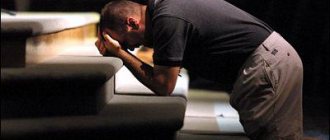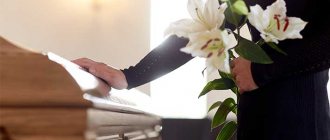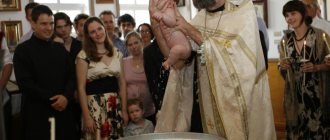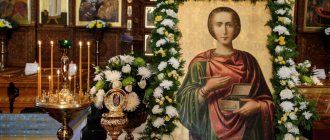Life of Saint Phanurius
Memorial Day: September 9
There are no documents about the life of the saint, no legends have been preserved, they learned about him under unusual circumstances. On the island of Rhodes in the 16th century, Muslim occupiers discovered the ruins of a small church. Among the rubble they found an icon, intact and bright, unlike all the others. This icon depicted Phanurius in the center with a cross in his right hand and twelve marks in a circle. Each of the marks was a depiction of a scene from the life of the martyr Phanurius: his prayers, the tortures he endured, the defeat of the evil one. It was thanks to this icon that the holy martyr Fanuria became known. A church in honor of Saint Phanurius was restored at the same place, and miracles soon began there.
What do they pray to the miracle worker for?
Translated from the Greek language into Russian, the name Phanurius means “pointing”, “revealing”. Traditionally, those who wish to find a lost item or find a missing person turn their prayers to the saint. The saint also helps those who have lost their bearings in worldly life to find the meaning of life and find the true path.
The miraculous deeds of Saint Phanurius
Three righteous deacons crossing from the island of Crete to Kythira were captured by Muslims and brought to Rhodes, where they were going to be sold into slavery. The men did not mourn their fate for long, but when they learned about the great martyr, they began to pray to Fanurius for help. The deacons nevertheless ended up in captivity to three different masters, but by the grace of God they all received permission to pray to Saint Phanurius in his church.
It so happened that the deacons arrived at the temple at the same time, they together prayed to Saint Phanuri the Wonderworker for deliverance from slavery. That same night, all the owners dreamed of a martyr, ordering the slaves to be freed so that they could serve the Lord, and he promised punishment for disobedience. But Muslims did not attach any significance to dreams. The next night everything happened again. In the morning the owners woke up blind and paralyzed. They immediately understood what was happening and sent messengers for the priests, who said that prayers would help them heal and get rid of pain. Fanuriy again appeared to the Muslims with orders to send documents to the church releasing the clergy. The letters were sent by messengers to the church and placed near the icon of the martyr. A miracle happened - blindness and pain disappeared. The priests, taking the image of Saint Phanurius, went to Crete.
Biography (life). AYOS FANOURIOS
Saint Nicholas of Serbia (Velimirović): “Children do not need to despair because of the sins of their parents. After all, this is not blind fate. The all-merciful Lord can stop punishment on children if true repentance and prayer to Him, the Heavenly Father, for forgiveness are shown. The mother of Saint Fanurius (August 27/September 9) was a dishonest woman, but her son did not suffer punishment for his mother’s sins. Not only did he not suffer punishment, but he became a saint. Fanurius, realizing that his mother was a sinner, constantly prayed to God for her. You also pray to God for your relatives and parents. When the Lord forgives dead sinners, then their sin will not fall as a heavy burden on the shoulders of their descendants. This is the meaning of prayer for the dead - so that the Lord forgives their sins” - St. Nicholas of Serbia. // Saint Nicholas of Serbia (Velimirovich). About the three most important things. Selected letters to spiritual children.
Little is known from reliable sources about Saint Fanouris the Great Martyr. Living around the third century AD, he came back to us through an iconographic image discovered on the island of Rhodes in the 16th century. Then the local Algerian administration, which was a vassal subordinate to the Ottoman administration, decided to repair the fortress walls. The builders, the Greeks, began work. While dismantling one of the dilapidated walls, they came across a tiny built-up early Christian church. Time and dampness turned almost all the icons here into dust. Only one stood out for its integrity. The Orthodox realized that they were facing a miracle. The icon was taken to the Metropolitan of Rhodes Nil. He began to study the image with surprise. A young man dressed in the rich uniform of a Roman officer was looking at him. The signature read: Agios Fanouris. Revealed. Judging by his name, the young man was of Greek origin. Smaller pictures running along the edge of the main image showed the Metropolitan scenes of the Saint’s torment. Here he is interrogated with passion. The Roman commander's subordinates, dissatisfied with what they heard, hit Fanuris in the mouth with stones. The anger of the Alachi is growing. They are already beating the saint with sticks. He fell from the blows. The half-dead and naked martyr is thrown into prison, where he indulges in prayer. Interrogation again. The executioners burn the body of Fanouris. Then they use some kind of torture mechanisms. Having lost patience, they throw the saint into a pit with wild animals. But they don't touch Fanouris. Then he is tortured by fire again. The saint is burned. He accepts death with a calm expression. Metropolitan Nil must have had an outstanding mind, for he conducted a whole study of the paintings on the icon. It was he who determined the approximate date of Fanouris’s life, based on the period of the most severe persecution of Christians. The Saint's parents were believers themselves, as they gave their son a sonorous name. It was dangerous though. In one of the versions of the life of Saint Fanouris, I happened to read that “his mother was a bad person.” Even that “harlot”. And her son prayed for her. Where did such a version come from if it was not among the images? There are, of course, revelations. The saint appears to people through prayer. Maybe he told someone something like that. Metropolitan Nil did not find anything like this on the icon; I repeat, this is the only tangible source of information. And it is doubtful that a bad woman would give her child a good Christian name. Moreover, at that time believers were very strict in their morals. Lord Nil appealed to the head of the occupation administration with a request to give permission to build a special temple in honor of the discovered Saint. But he was refused. He did not humble himself, for he saw a miracle in the appearance of the icon. Sign. I went to Constantinople to see the Patriarch himself. From the point of view of the Turks, this position is an bureaucratic one. Moreover, this remains the case to this day. The Patriarch is the mediator and responsible for all Orthodox Christians in Turkey. Nile's request was submitted to the Sultan and permission was obtained to build the temple. It still exists in Rhodes and is considered one of the island's attractions.
Troparion, Kontakion and Glorification of the Great Martyr Phanurius Troparion, tone 4: Heavenly singing on earth is performed brightly, earthly triumph is now celebrated radiantly. The angelic life of grief praises suffering, down to the Church - heavenly glory, which you gained through your illnesses and suffering, Phanuri is more glorious. Kontakion, tone 3: The priests saved the godless from captivity and broke the bonds with divine power, God-wise, disgracing the tormentors of insolence, wisely, they rejoiced the angels of the rank, great martyr. For this sake, we honor you, divine armorer, the more glorious Fanurie. The greatness of those who kiss your honorable icon with faith and ask for your help, martyr, heirs of the divine Kingdom, Fanurie, show everything with your prayers.
Great Martyr Fanourius - commemorated on August 27/September 9 - is especially loved and revered in Greece. His name means “revealer, revealer.” After finding the icon, miracles began to happen through prayer to the Saint. The list of them is not huge. To this day, many miracles are performed at the icon. Martyr Phanurius immediately helps those who call on him with faith and reverence. Although the Orthodox Church rejects any specialization of saints, the saint is most often approached with a request to help find what has been lost, suggest a way out of a difficult situation, and also “show health” to the sick. Or just find something or someone: a job, housing, or even a betrothed. On the day of remembrance of the Great Martyr Fanourius, young girls in Greece bake a cake with a prayer that the saint will help them make the right choice as a life partner. And Athonite monks bake this cake just for tea and pray to the martyr to help him find the missing things. And it helps!
Fanuropita - St. Fanourius' cake
4 cups wheat flour, 4 teaspoons baking powder, 1 teaspoon ground cinnamon, 1 cup raf. vegetable oil, 1 1/2 cups sugar, zest of 1 lemon, 1/2 cup orange juice, 1/2 cup water, 1/2 cup white raisins, 1/2 cup black raisins, 1/2 cup crushed walnuts, salt to taste, powdered sugar. In a tall bowl, mix flour, baking powder and cinnamon, add butter, sugar, lemon zest, pour in orange juice, water, mix all ingredients thoroughly again for several minutes. Then add raisins, nuts, salt and mix very well again. Grease a round baking dish with butter and lightly sprinkle it with flour. Place fanuropita on it. Bake (150-180°) for 45 minutes. Cool, sprinkle with powdered sugar and cut. Fanuropita becomes tastier a day after baking, especially if washed down with monastery tea.
Prayer for the blessing of the pie of St. Fanurius (fanuropita), read by the priest Lord Jesus Christ, Heavenly Bread, food, abiding forever, generous giver, giver of good things, Elijah, pouring out food untouched, hope of the unreliable, help of the helpless and salvation of our souls! Bless these and these gifts to You who brought to Your glory and honor the holy, glorious Great Martyr Phanurius. Grant, O Blessed One, to those who decorate these pies with all Your peaceful and worldly goodness. Thy face made me glad with joy, show them the path to salvation. Fulfill the requests of their hearts and all their advice quickly, instructing them to do Your commandments, so that with joy and joy they sing and glorify Your most honorable and magnificent name, through the prayers of the most blessed Mother of God, the holy and glorious Great Martyr Phanurius, the wonderworker, and all Your saints. Amen.
My acquaintance with Saint Phanourius. While vacationing on the Greek island of Rhodes, we wandered through the ancient narrow streets of the old city of Rhodes under the scorching sun, and almost got lost in their intricacies, when suddenly we found ourselves near an Orthodox church. It looked very strange - like a canopy roughly put together from metal sheets, reminiscent of a garage. This surprised me very much, since Greek temples are usually built of stone, and with very great architectural taste. Having become interested, we entered under the canopy, found ourselves in a small courtyard, which was all decorated with flowers, then we had to go down steeply. We went down, and lo and behold, we suddenly entered an ancient Byzantine temple, which for some reason had gone deep underground. There was no one in the temple, the lamps were burning, there were again many flowers, silence and coolness reigned. The noisy and sultry tourist city that remained above seemed to have disappeared; it seemed that we had stepped into another era, long before the Latin and Turkish occupation. Several icons of the same saint hung on the walls. We kissed them and read: “Agios Fanourios.” Having returned home and found information, I learned that the Great Martyr Phanurius is precisely the main saint and patron of the island of Rhodes, and his icon is the main shrine. And we were in this temple on the day of its veneration. So Saint Fanurius, out of his love and condescension, arranged it so that we, without even planning it, ended up at his Miraculous Icon. Now the icon with his face has taken its rightful place in our home iconostasis. And the Lord, through prayer to Saint Phanurius, repeatedly helped me and my loved ones.
Prayer to Saint Phanurius in Russian
O holy servant of God, martyr Fanurie! Having fought a good fight on earth, you have received in Heaven the crown of righteousness, which the Lord has prepared for all who love Him. In the same way, looking at your holy image, we rejoice at the glorious end of your life and honor your holy memory. You, standing before the Throne of God, accept our prayers and bring them to the All-Merciful God, to forgive us every sin and help us against the wiles of the devil, so that, having been delivered from sorrows, illnesses, troubles and misfortunes and all evil, we will live piously and righteously in the present We will be worthy through your intercession, even though we are unworthy, to see good on the land of the living, glorifying the One in His saints, the glorified God, the Father and the Son and the Holy Spirit, now and forever. Amen.
( 4 ratings, average: 4.00 out of 5)
Holy Martyr Uar, life
The holy martyr Uar came from a noble family.
He was a military commander under the Emperor Diocletian and served in the army in Egypt during the persecution of Christians, at the end of the 3rd - beginning of the 4th century. Saint War secretly helped Christians imprisoned, bringing them food at night, supporting them, and healing their wounds. He was a secret Christian, but did not openly admit his faith. However, after one of the seven holy ascetics who were in prison for the faith of Christ died, Uar decided to take his place and opened himself before the judge at the trial. Huar was subjected to severe torture. They beat him with sticks, hung him from a tree, tore off the skin from his back and tore his womb so much that his insides fell out of it. Only after a few hours of torment, Saint Uar died, and several of his companions were executed along with him. Before this, at the request of Saint Uar, they offered prayers for the granting of strength to him to endure suffering with dignity.
The pious woman Cleopatra, who was present at the execution, waited until nightfall and, together with her son John and other Christians, took the remains of Huar to bury him in the basement of her house. After some time, Cleopatra decided to return to her homeland, Palestine, and took with her the Holy Relics of Huar, saying that it was her late husband. The relics of Saint Uar were placed near Mount Tabor. A Church was built there, where believers came to receive healing from the Holy relics.
During the holiday in honor of the consecration of the temple, the son of the pious Cleopatra unexpectedly died. His mother was inconsolable, sobbing she asked for help from Saint War, because she herself had helped him before. Exhausted from tears, the woman fell asleep and saw in a dream her son, who stood next to Saint Uar in the shining armor of the Holy Army. Uar reproached Cleopatra for her lack of faith and said that her son would stand before the throne of God; if he remained alive, he would serve the earthly king, and not the heavenly one. The son also assured his mother that he wanted to be with the Lord in Heaven. Cleopatra begged to take her with her, but Saint Uar replied that her time had not yet come, she still needed to work on earth for the glory of God.
Waking up, Cleopatra dressed her son's body in festive clothes and buried him. Having distributed all her property to those in need, she began to serve in the Church of St. War, in the same place where her son John was buried. When her time came, she went to the Lord peacefully, Cleopatra was buried next to her son.
Saint's life story
The future saint was born in the 4th century, in Ethiopia. For his dark skin color, he received the nickname “Murin”. Initially, Moses served as a slave in the family of a respectable citizen who did not beat or abuse his servants. However, the fate of a man who lives by honest and righteous labor did not appeal to the man, and he went against the law - divine and human. Moses drank and led a riotous lifestyle, which ultimately led him to a serious crime - murder. The owner immediately drove him out of his house, and Murin did not find anything more worthy than leading a gang of robbers.
For many years, together with his accomplices, Murin robbed, shed the blood of his compatriots, and deprived women of the honor and innocence. He had enormous physical strength and instilled fear in people. Once he even swam across the Nile, taking a sharp sword in his teeth, only to kill a shepherd who had offended him. Unable to grab the man, he angrily tore to pieces four lambs that were being watched by a shepherd. Like the barbarian Moses, he ate the meat raw, sold the skins, and drank wine for a week with this money. But one day he realized how low he had fallen and went to the gates of the monastery to beg the monks to accept him.
When they saw Moses at the gate, they decided that he was obsessed with murder, and began to prepare for death. But suddenly the robber began to cry and ask to be let in to repent. The monks did not immediately believe in the repentance of the murderer and robber, looking for an insidious catch in his actions. But Moses Murin stood at the gate on his knees for several days without food or food, and the monks let him in. Moses settled in a hermit's cell, where he prayed fervently and took in food no more than three hundred and fifty grams of dry bread and a glass of water a day.
He tirelessly read prayers, unquestioningly fulfilling all the instructions of his brothers, distinguished by meekness and asceticism. One day, his cell, which was located in a desert monastery, was attacked by four robbers. As it turned out, these were Moses’ former accomplices, but they did not immediately recognize him.
Moses Murin tied all four up like a sheaf and brought them to the monastery, saying that he would not take their lives. When the robbers realized that their former leader was in front of them and realized how much he had changed, they were shocked and also repented. Later they became the first disciples of Moses, taking monastic vows like him. Over the next fifteen years, Murin acquired 75 students and acquired the gift of foresight. Shortly before his death, the saint predicted an attack by dashing people on the monastery and persuaded most of the monks to leave for a safe place. Moses himself and his seven companions remained and suffered martyrdom at the hands of the murderers. After his death, he was canonized and recognized as a saint.
We advise you to study Prayers to St. Nicholas the Wonderworker for good luck and luck
Veneration of Saint Uar in Russia
The day of remembrance of Saint War and the Christians who were tormented with him, Blessed Cleopatra and her son John - October 19, old style, November 1, new style.
- Saint Uar is especially revered in Rus'. This is connected with the name of the Holy Righteous Tsarevich Dmitry, the youngest son of Ivan the Terrible. Tsarevich Dmitry was born on October 19, 1582 on the day of remembrance of the Holy Martyr Huar. After the death of Tsarevich Dmitry, the people began to pray at the relics of the youth, which were located in the chapel of St. Uar of the Archangel Cathedral of the Kremlin.
- Believers prayed for the children, and through their prayers healings and other miracles were performed.
- They pray to Saint War for children and the health of babies. There is also a tradition to consider Saint War a prayer book for those who died in unbelief, without the sacrament of Baptism, for drunkards who hanged themselves and sectarians who have lost their minds. In church they pray for the children of the Church, but privately, in home prayer, people ask Saint Uar for intercession, asking for a blessing for this.
Life
Saint Fanourius [1] probably lived in the 3rd century, although there is no reliable information about his origins and time of life. Everything we know about this saint is known from the Greek tradition.
So, in the 16th century, Muslims captured the island of Rhodes. The new ruler decided to restore the fortress walls damaged in the wars. Near the fortress there were several destroyed buildings, the stone from which was used to repair the walls. During restoration work, Muslims discovered the ruins of a small church, which later turned out to be very beautiful. Several icons were found on the floor, most of which were badly damaged. But one icon looked completely new, as if it had been painted on the same day. The local bishop Nil, who was called to examine the icon, said that it was an image of St. Fanurius. Actually, this image provided information about the life of the saint.
Fanurius was depicted as a young soldier holding a cross in his right hand, above which a candle was burning. Twelve marks are written around his image, telling about individual episodes of his life. So we learn that he was interrogated by a judge, beaten by soldiers, then lashed with whips and torn at his body with iron hooks. After that, the saint was locked in prison and again brought to trial before an official, and then they were burned with candles, thrown to wild animals, and placed under a huge stone. The following scenes show him standing in front of idols, holding burning coals in his hands. At that moment, behind the martyr stands a crying Satan, having suffered defeat from the saint. The last mark shows Fanurius in a fiery furnace, with his hands raised in prayer. From this it is clear that the saint endured great torment for his faith in Christ.
Bishop Neil asked the Muslim ruler of the island for permission to rebuild the church, but was refused. Then he went to the capital and received a decree allowing the temple to be restored.
At that time there was no Orthodox bishop in Crete. At that time the island was under the rule of Venice, so there was only a Latin bishop there. After the death of the Greek bishop, the Venetians did not allow him to ordain a successor, in the hope that the local population would soon convert to the Catholic faith. Those who wanted to take holy orders had to go to the island of Kythera.
One day, three young deacons went from Crete to Kythera to be ordained as a priest. On the way back they were captured by Muslims and brought to Rhodes to be sold into captivity. The priests mourned their fate for three days until they heard about the miracles of Saint Phanurius. They began to pray to the great martyr for deliverance from slavery. Soon each of them was sold to different owners. By the grace of God, they were all allowed to pray in the restored church of St. Phanourius. It so happened that they all arrived at the temple at the same time and prayed in front of the icon of the saint for deliverance from Muslim captivity. After the prayer, the priests each returned to their masters.
The following night, a miracle happened - Fanurius appeared in a dream to each of the three masters and ordered the priests to be freed so that they could serve God. If they refuse, the saint promised to punish them. Three Muslims did not attach any significance to their dreams, believing that they were some kind of witchcraft. They chained the slave priests and began to treat them even worse than before.
The next night, Fanurius again appeared in a vision to the three masters, and warned that if they disobeyed this time, they would see God’s power. The next morning, all the residents of the houses where the priests were located woke up blind and paralyzed, and at the same time experienced severe pain. They realized what they had to do and sent for the priests. They were asked if they could heal everyone. To this the priests replied that they would pray to God and He would manage everything.
After this, Fanurius again appeared to those Muslims and told them to send documents to the church giving the priests freedom, and if they did not do this, they would not be healed. The three owners sent letters to the church, where they were placed in front of the icon of St. Fanourius. As a result, all those suddenly struck were healed, and the priests went to Crete, taking with them a copy of the image of the great martyr.




